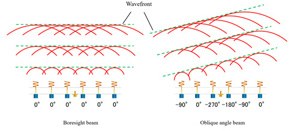Mitsubishi Electric Corporation announced its development of the REESA (Rotational Element Electronically Scanned Array) antenna, a small, low-cost array antenna that achieves high-precision beam scanning by electronically rotating antenna elements individually. The REESA antenna is suitable for airport radar systems, mobile satellite communication systems and possible new applications such as microwave-based industrial heating and mounting on drones for long distance data transmission. Commercialization of the product is targeted at 2020.
Key Features
- Rotates antenna elements individually for precise phasing and beam scanning
- Controls phase by rotating circularly polarized antenna elements individually by motors.
- Realizes high-precision beam scanning by controlling phase in approx. two-degree increments.
- Smaller and less expensive than conventional mechanically driven parabola antenna 2/3.
- Achieves high efficiency and low power consumption
- Uses a hollow waveguide for the antenna feed to achieve high efficiency of 85 percent in 12 GHz band
Development Background
Airport radars and mobile satellite communication systems conventionally use mechanically driven parabola antennas or AESAs, which electronically scan antenna beams with RF modules. The size and weight of the drive mechanism can be a problem in the case of parabolic antennas, while AESAs require expensive RF modules for each antenna element and achieve only limited accuracy in phasing required for high-precision beam scanning.
Details
- Rotates individual antenna elements for precise phasing and beam scanning without RF modules Given that a circularly polarized antenna element can be rotated to change the phase of the radio wave radiated from the element, the REESA antenna rotates antenna elements individually to control the phase. It achieves high-precision electronic beam-scanning by controlling the phase in increments of approximately two degrees based on the angular accuracy of the motors, which is some 5 to 10x more precise with conventional AESAs. Mitsubishi Electric used its prototype REESA, which has 168 antenna elements, in a broadcast-satellite reception test to confirm that the beam could be scanned electronically in the satellite’s direction to receive the broadcast video.
- Achieves high efficiency and low power consumption Mitsubishi Electric adopted a radial line waveguide for the antenna feed using a hollow-type distribution circuit, resulting in 85 percent efficiency in the 12 GHz band. The structure is simple and produces low loss since the radial line waveguide is a hollow distribution circuit composed of two conductor plates arranged at a predetermined interval.

